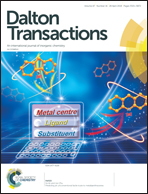High switchable dielectric phase transition originating from distortion in inorganic–organic hybrid materials (H2dabco-C2H5) [MIICl4] (M = Co, Zn)†
Abstract
Two phase transition materials (H2dabco-C2H5)[ZnCl4] and (H2dabco-C2H5)[CoCl4] were synthesized and characterized. Differential scanning calorimetry detected that the two compounds underwent reversible phase transitions at 245 K and 261 K, respectively. The temperature dependence of the dielectric measurements also confirmed the phase transition. Variable-temperature single-crystal X-ray diffraction suggested that the two compounds underwent the same phase transitions from the space group Pnma to P21/c but at different temperatures. Symmetry breaking occurred with an Aizu notation of mmmF2/m. The structural phase transitions of 1 and 2 were ascribed to the distortion of a [H2dabco-C2H5]2+ cation from inorganic–organic hybrid materials (H2dabco-C2H5)[MIICl4] (M = Zn, Co). The strong variations of dielectric anomaly made compounds 1 and 2 applicable for use in promising switchable dielectric materials.
![Graphical abstract: High switchable dielectric phase transition originating from distortion in inorganic–organic hybrid materials (H2dabco-C2H5) [MIICl4] (M = Co, Zn)](/en/Image/Get?imageInfo.ImageType=GA&imageInfo.ImageIdentifier.ManuscriptID=C8DT00623G&imageInfo.ImageIdentifier.Year=2018)


 Please wait while we load your content...
Please wait while we load your content...